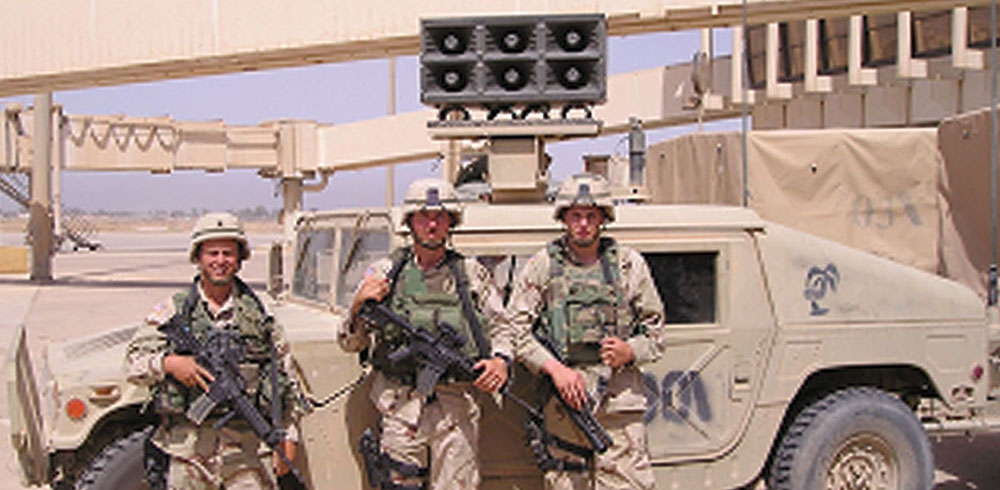DOWNLOAD
Tactical Psychological Operations (PSYOP) supported the full spectrum of the force during Operation IRAQI FREEDOM (OIF). Both active and reserve component units supported special operations forces and Army and Marines conventional forces. The 9th Psychological Operations Battalion, reinforced with several Army Reserve PSYOP companies, provided support to both the Coalition Forces Special Operations Component Command (CFSOCC) and Coalition Forces Land Component Command (CFLCC). The battalion headquarters also formed a V Corps PSYOP Support Element (CPSE) under the control of the battalion commander, Lieutenant Colonel (LTC) Glenn Ayers.
Tactical PSYOP companies, including those of the 9th PSYOP Battalion, provided support to both conventional and special operations units across Iraq. Alpha Company supported Combined Joint Special Operations Task Force (CJSOTF)-North and 10th Special Forces Group (SFG) in northern Iraq, while B Company, augmented with Reservists from the 301st PSYOP Company, supported CJSOTF-West and 5th SFG in central and western Iraq. Charlie Company supported the 3rd Infantry Division and provided a detachment to the 1st Marine Expeditionary Force (MEF). The 315th PSYOP Company replaced C Company and assumed responsibility for Baghdad in June 2003. Even with the detachment from the 9th PSYOP Battalion, the majority of PSYOP support for the 1st MEF—comprised of 1st Marine Division, Task Force Tarawa, and the 1st United Kingdom Armored Division—came from the 305th PSYOP Company. Rounding out the tactical PSYOP picture, the 318th PSYOP Company provided support the 101st Airborne Division.
Tactical PSYOP companies and teams all had similar missions and shared common experiences. The following vignettes highlight some of those common experiences, and a few not-so-common adventures, during the early months of Operation IRAQI FREEDOM.

Fighting Bullets With Words
Junior noncommissioned officers operating independently from their detachments and company elements accomplished the majority of the work conducted by Tactical PSYOP Teams (TPTs). In many cases, these sergeant-filled TPTs supported conventional armored units, as did TPT 1092, an Army Reserve element from the 318th Tactical PSYOP Company out of St. Louis, Missouri.
During a battle at a grain warehouse west of Al-Hillah, TPT 1092—Sergeant (SGT) Bryant Pilant, SGT Shawn McCauley, and SGT Jeremy Corcoran—supported the 101st Airborne Division’s 3rd Brigade Combat Team. While under heavy enemy fire, the TPT maintained contact with the task force commander in order to get the loudspeaker team into the fight. In order to broadcast surrender appeals to the enemy over the noise created by the intense weapons fire and supporting OH-58D helicopters, the team moved its vehicle to the front gate, and at times inside the perimeter, of the grain warehouse occupied by enemy forces. With machine gun and rifle rounds impacting all around, TPT 1092 completed their mission and continued to broadcast. SGT Pilant assumed a dismounted fighting position alongside the team vehicle and returned fire in order to allow SGT McCauley to employ the loudspeaker system. SGT McCauley maintained his position in the exposed gunner’s hatch throughout the entire engagement. TPT 1092’s only casualty from the battle was their vehicle’s water pump, which had to be replaced.
Besides responding to fire with words, TPT 1092 found themselves fulfilling a number of other missions in support of the 101st Airborne. In one case, the TPT contributed to the capture of several members of a Syrian mercenary death squad by broadcasting extremely effective surrender appeals. Having the only interpreter in the task force, the TPT also actively gathered information from local civilians, Iraqi prisoners of war, and captured Syrian mercenaries.1 TPT 1092 truly represented the tactical flexibility of tactical PSYOP.

More Tactical Than PSYOP
TPT 983 of C Company, 9th PSYOP Battalion also found itself in several tense situations while performing tactical PSYOP missions. Along with several other teams, TPT 983 supported 3rd Infantry Division. They conducted a variety of missions, usually near the forefront of operations. One such mission brought more excitement than the PSYOP soldiers expected.
At 2100 hours on 10 April 2003, TPT 983 supported 2-69th Armor in a mission to destroy a large weapons cache located in the Al Kazimiyah area of Baghdad. The PSYOP team—SGT Joseph Tetreault, Specialist (SPC) Buryl Ewing, Private First Class (PFC) Justin Warden, and an Arabic linguist—traveled in their M1025 HMMWV Armament Carrier, behind an M1A1 tank and ahead of two M2A2 Bradley Fighting Vehicles (BFVs). Moving in a tactical column, the convoy reached the weapons cache without incident. Once at the site, Captain (CPT) James, the patrol leader, tasked the TPT to broadcast a civilian noninterference message and warning messages of the upcoming explosion. TPT 983 broadcast for five minutes, and then travelled the four hundred meters to the rally point. The tank and the BFVs destroyed the weapons cache, then moved to the rally point and the column started to exit the area. The convoy had moved only a few hundred meters when an explosion occurred about fifty meters behind them. Insurgents had taken the opportunity to attack the patrol under cover of darkness.
The explosive concussion swept over TPT 983 in its M1025, rendering all four men unconscious. SGT Tetreault felt shrapnel impact his Kevlar helmet and decided it was similar to a kick in the head before he blacked out. Almost immediately, Tetreault regained consciousness to the sound of small arms fire, but found it difficult to see because of dust and debris in the air. Aiming mostly by sound, SGT Tetreault returned fire and started yelling for his soldiers. As he turned to look at his driver, Tetreault noticed a large baseball-sized hole in the windshield. PFC Warden was slumped over and unresponsive in the driver’s seat. As the vehicle continued to roll forward at about fifteen miles-per-hour, SGT Tetreault quickly checked on his turret gunner, only to find him missing, evidently blow out of the turret by the explosion.


